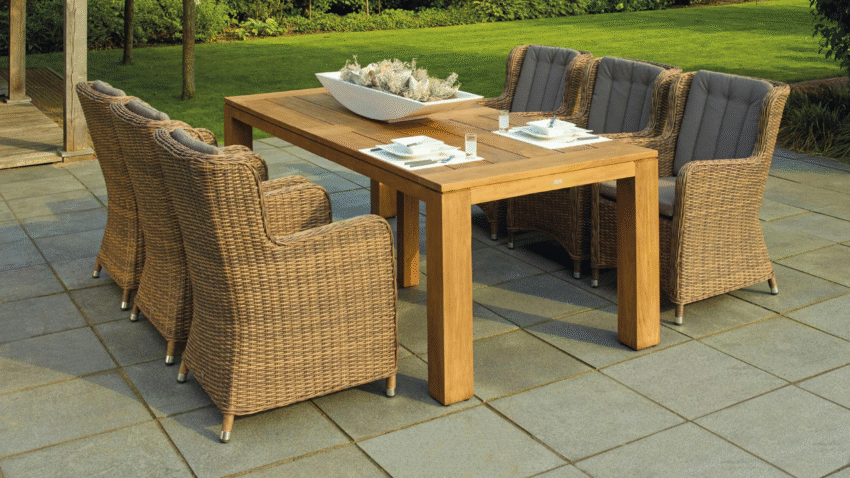Introduction
A patio is more than just an outdoor surface—it’s a space for entertaining, relaxing, and enjoying fresh air. But like any investment, patios require proper care to stay safe, functional, and attractive. Whether your patio is made of concrete, stone, pavers, or wood, learning how to extend the lifespan of any patio ensures it remains in great condition for decades. If you’ve ever noticed cracks, weeds, stains, or fading, this guide will give you the strategies to protect and preserve your patio, no matter the material.
Why Patio Maintenance Matters
All patios face the challenges of weather, foot traffic, and time. Without upkeep, problems multiply:
- Concrete patios: Develop cracks and stains.
- Stone or paver patios: Shift, loosen, or grow weeds between joints.
- Wooden decks/patios: Suffer from rot, fading, and insect damage.
Regular care saves money on costly repairs, keeps your patio safe, and maintains curb appeal.
Step-by-Step Guide to Extending Patio Lifespan
1. Clean Regularly
Routine cleaning is the simplest way to prevent long-term damage:
- Sweep weekly to remove dirt, leaves, and debris.
- Wash monthly with mild soap and water.
- For deep cleaning, use a garden hose or pressure washer (on low to medium settings).
This prevents staining, mold, and buildup that shorten patio life.
2. Control Weeds and Moss
Weeds and moss weaken paver and stone patios:
- Pull weeds manually or use a weeding tool.
- Sweep polymeric sand into joints to lock pavers and block new growth.
- Spray vinegar or a mild weed solution for stubborn areas.
Keeping joints clear reduces shifting and erosion.
3. Protect Against Moisture
Moisture is the main enemy of patios:
- Ensure proper drainage with a slight slope away from your house.
- Avoid standing water, which causes erosion, mildew, and cracking.
- For wooden patios, apply water-repellent sealants every 1–2 years.
Dry patios last significantly longer than damp ones.
4. Seal Surfaces for Protection
Sealers add an extra layer of defense:
- Concrete: Apply penetrating sealer every 2–3 years to prevent cracks and stains.
- Pavers: Seal to reduce fading and protect joint sand.
- Stone: Use breathable stone sealer to prevent moisture damage.
- Wood: Reapply stain or protective coating every 1–2 years.
Choose sealers designed for your specific patio material.
5. Manage Furniture and Accessories
Patio furniture and décor can cause damage over time:
- Use pads under chair and table legs to prevent scratches.
- Move furniture occasionally to avoid uneven fading or wear.
- Place trays under potted plants to stop water rings and stains.
Simple precautions keep surfaces looking even and clean.
6. Address Stains Immediately
The faster you treat stains, the easier they are to remove:
- Oil and grease: Sprinkle baking soda, scrub with dish soap, rinse.
- Rust: Use a rust remover safe for patio materials.
- Food or wine: Wash quickly with warm, soapy water.
Immediate cleaning prevents stains from becoming permanent.
7. Inspect and Repair Regularly
Catch small issues before they become big problems:
- Check for loose pavers or cracked tiles each season.
- Fill small cracks in concrete with patching compound.
- Replace damaged boards or stones right away.
Routine inspections save money and preserve patio strength.
8. Protect from Sun Damage
Sun exposure fades colors and weakens surfaces:
- Add umbrellas, awnings, or pergolas for shade.
- Use UV-protective sealers or stains.
- Rotate rugs and textiles to even out sun exposure.
A balance of shade and sunlight keeps your patio both functional and vibrant.
9. Prepare for Seasonal Changes
Each season brings unique challenges:
- Spring: Deep clean, check for winter damage, reseal if needed.
- Summer: Control weeds, add shade, inspect for cracks.
- Autumn: Remove leaves promptly to avoid stains.
- Winter: Use plastic shovels for snow, avoid harsh ice-melting salts.
Seasonal care ensures your patio adapts to changing conditions.
10. Prevent Insect Damage
Wooden patios and decks are especially vulnerable:
- Apply termite-resistant sealants.
- Keep mulch and firewood away from the patio perimeter.
- Inspect for signs of insects like sawdust piles or hollow-sounding boards.
Preventing pests protects structure and safety.
Common Mistakes to Avoid
- Mistake: Using harsh chemicals.
Solution: Choose mild cleaners or products designed for patios. - Mistake: Overpressure washing.
Solution: Use a medium setting—too much pressure damages surfaces. - Mistake: Neglecting drainage.
Solution: Always slope patios and clear drains to prevent water pooling. - Mistake: Skipping sealing.
Solution: Reseal every few years for long-term protection. - Mistake: Forgetting seasonal prep.
Solution: Adjust care routines with the weather to stay ahead of damage.
Extra Patio & Deck Tips & Hacks
- Eco-Friendly Cleaning: Mix vinegar and water for a safe, natural cleaner.
- Quick Refresh: Repaint furniture or replace cushions for a seasonal update.
- Add Longevity: Use outdoor rugs to protect high-traffic areas.
- Related Guide: For wood care, see our article on How to Reapply Protective Coating to Decking.
Conclusion
Extending the lifespan of any patio comes down to consistent cleaning, sealing, and smart care practices. By controlling weeds, protecting against moisture and sun, repairing promptly, and preparing seasonally, you’ll ensure your patio remains safe, beautiful, and durable for years.
A little regular maintenance goes a long way—protect your patio now, and it will reward you with decades of enjoyment.
